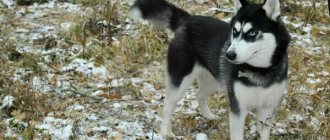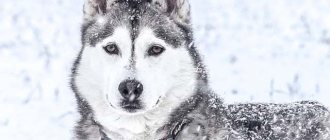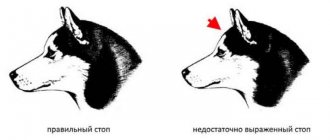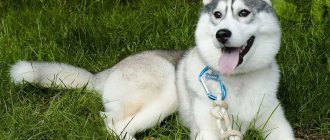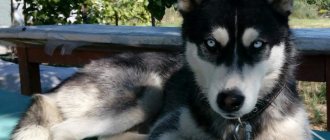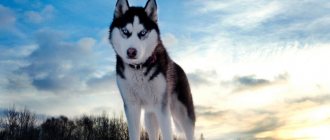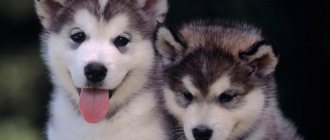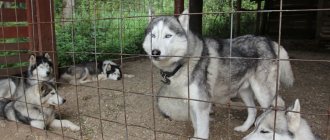Contents in the apartment
There is an opinion that huskies should not be owned in a city apartment:
- Northern sled dogs love space and cold. The apartment suffers from heat and cramped conditions.
- Aviary animals shed in spring and autumn for 3–4 weeks. In indoor dogs, biological rhythms are disrupted and hair falls out all year round.
- Huskies cannot be left alone. They chew things and furniture, tear off wallpaper and floors.
Meanwhile, many owners managed to cope with difficulties and accumulated positive experience of keeping a husky in a city apartment:
- According to the observations of the owners, dogs normally tolerate the heating season and summer heat. The double coat protects animals from overheating. The light fluffy undercoat together with the guard hairs form an air layer. It does not allow heat and cold to pass through, creating a comfortable temperature at the surface of the skin.
- In summer, at temperatures of 30℃ and above, both animals and people suffer. At home, it is useful to turn on the air conditioner and additionally lay out a cooling mat for your pet.
- Huskies do not shed more than other breeds with thick coats. If you brush it regularly with a furminator, the hair will not fly all over the house.
- The issue of cramped space is controversial. Huskies need a loving, attentive owner. If the owner disappears 12 hours a day at work, then it makes no difference to the dog where to sit locked up - in an enclosure or in an apartment.
- The behavior of a husky depends on the owner. Adequate owners hide shoes, clothes, remote controls, phones and other things away. From an early age, the puppy is accustomed to “chew” toys, rewarded for every contact with them.
- On walks, the dog is allowed to throw out its accumulated energy. They select such a level of physical activity that there is no strength or desire left to organize pogroms.
Ideal order and cleanliness in the house is difficult to maintain with any dog, even a small breed.
How often can you bathe?
For a dark (brown/black) dog, it is enough to wash it 1-2 times a year. It makes sense to time the bathing to coincide with the molting period - this will speed up the process of getting rid of dead vegetation.
An alternative to water procedures throughout the year can be:
- swimming in the snow - thanks to the warm undercoat, this measure is pleasant and safe for the dog;
- using sprays with dry cleaning functions - this procedure can be carried out every week.
Unscheduled full washing is acceptable for:
- white huskies – even minor dirt is visible on them. However, if possible, it is better to choose dry washing or use a grooming spray;
- exhibition pets – it is advisable to wash them before and after the exhibition. In both cases, hygiene can be combined with preventive antiparasitic treatment (regardless of the season);
- situations with severe contamination - when a waterless procedure is not able to help.
Bathing too often can lead to:
- dryness, irritation and itching of the skin;
- the appearance of an unpleasant odor - against the background of increased work of the sebaceous glands;
- loss of the coat’s “warming” and water-repellent functions;
- changes in the hair structure - excessive oiliness, silkiness, softness, loss of elasticity.
Under natural conditions (rain, sleet), the dog’s thick “fur coat” does not get wet much. However, after bathing with shampoo, long drying is required - which is unsafe in the cold season or when kept outdoors.
At the same time, you need to wash your paws (and, if necessary, your stomach) after every walk. If an adult animal gets wet in the rain, it is enough to wipe it with a dry towel at home.
How to walk with a husky
The puppy begins to be taken outside after the first two-stage vaccination, from about 3 months. They are accustomed to the collar and leash in advance, wearing it at home for 15 minutes a day. Until contact is established and the command “Come to me” is firmly mastered, they are not allowed off the leash.
For a puppy, being outside opens up a new world of sounds, smells, strangers and dogs.
Even huskies trained to call often get carried away and run away. The only way to eradicate a bad habit is to become interesting to your dog.
To release the energy of huskies, measured walking is not enough; they need physical and mental exercise:
- Intensive training: learning basic commands, tricks.
- Jogging behind the owner's bike.
- Skiing.
- Driving loads with sledges and sleds.
It is a common belief that you need to run 10 km a day with a Husky. This is true for sporting dogs that are being trained for competition. Domestic huskies are different, not everyone likes to cover kilometers and carry loads. Running is completely replaced by intensive training of active teams and active games.
Huskies love active walks.
Two walks a day for 15 - 30 minutes are clearly not enough for a husky. Usually they spend from 3 to 5 hours a day outside, but for a dog it is not the duration of walks that is more important, but the intensity of the load.
About bathing
The Siberian dog does not need frequent water treatments at all. On average, full bathing can be done two to three times a year . Some owners prefer to involve their pets in such procedures once a year. Which, by the way, is also normal.
Let me note that I’m talking about washing from head to toe, and not about tidying up paws after walks. Last care, of course, is needed much more often. I would recommend it after every promenade. Moreover, the Siberian dog does not always react favorably to attempts to wash his paws. Therefore, it is highly advisable to practice such care from puppyhood so that the animal gets used to it.
Which shampoo to choose? Specialized for dogs, of course. But the type depends on the needs. The means are as follows:
- Medicinal;
- Adding volume;
- Whitening;
- Suitable for any type of skin.
Special conditioners for dog fur coats are also produced.
The most ordinary bath is suitable for bathing, but in warm weather it is quite possible to do it outside. The main thing is that the water is warm. I recommend lathering the fur with a sponge, and carefully, since there should be no contact with the nose, eyes, mouth or ears.
It is also important to ensure that shampoos and soaps are thoroughly washed off. These products often accumulate between the front and hind legs, causing irritation in animals.
If your dog has access to the outside after bathing, I recommend keeping a close eye on him. The fact is that he may want to regain his natural smell, and will rush to do this by lying on the ground. I think this is the last thing the owner wants after spending minutes in the bathroom.
2 or 3 days after the bath procedures, I advise you to carry out preventive treatment of the cover against ticks and fleas. The choice of means for this purpose is now quite wide - these are drops, solutions, sprays.
Living in a private home
In a country house it is easier for the owner and more comfortable for the dog. Huskies are not afraid of the cold and live quietly outside all year round. Before the pet arrives, the area is fenced off with a well-buried fence no less than 1.85 m high. Huskies know how to climb over fences and are skilled at digging.
If a husky decides to run away, obstacles will not stop him.
A spacious enclosure made of stainless steel is built in a shaded area:
- A canopy is installed on top to protect from sunlight and precipitation.
- At least 2 walls are left open so that the home is well ventilated.
- A recreation area is arranged inside: a booth or bedding.
- Set out bowls for food and water.
Huskies are not chained to guard the house. They are too good-natured towards strangers and will never become vigilant watchmen.
Aviary dogs also need walks, intensive training or sports activities. If the pet is released onto the property, then bad habits are taken into account: huskies like to dig holes in beds and flower beds, and hunt poultry and small animals.
Features of bathing a Siberian Husky
It is necessary to accustom an animal to bathing from childhood. Husky puppies are not usually afraid of water. The main thing is to encourage your dog’s love for water procedures, if possible - in the summer, walk with your pet near bodies of water.
Immediately before you wash your Husky, you need to prepare the bathroom. Cover the floor and place shampoos and conditioners so that you can quickly grab a bottle while holding the dog with your hand.
- Wet your pet's fur evenly.
- Carefully distribute the shampoo over the body, not forgetting the neck and areas between the hind legs.
- Rub the foam into the undercoat using massaging movements.
- Rinse off the shampoo with warm water. Apply a special anti-tangle conditioner. Gently massage the coat and rinse off the conditioner.
You also need to dry your dog properly. It is necessary to use a special gun and dry it with a hairdryer at the very end. The main condition: do not rub the animal or try to comb out the wet undercoat. Otherwise, the risk of damage to the guard hairs will increase. As a result, the fur will become harsh and scratchy.
Such simple instructions are not easy to follow at home. Husky is a very active breed of dog. Holding a pet alone is quite difficult. And after finishing washing, you will have to do a general cleaning in the bathroom. To ensure that bathing is not stressful for either the animal or the owner, you should seek help from the grooming salon “ARTEMONoff”. The masters have extensive experience working with large breeds of dogs and know how to restore hair damaged as a result of improper home care.
Grooming
Husky wool repels water and dirt due to natural lubrication and a reduced number of scales on the surface of the hair.
Dogs are bathed with zoo shampoo no more than 2 times a year. Human detergents are drying and irritating to pets' skin. The rest of the time, wash off the dirt with cool water. From frequent bathing, the hair loses its ability to clean itself, and a dog smell appears.
During shedding, the fur is combed with a furminator every 3 days. The old undercoat is completely removed in 4 – 6 treatments. You will have to use a comb and a slicker brush every day until the end of shedding.
The rest of the time, the coat is combed once every 7-14 days with a furminator or 2-3 times a week with a fine-toothed comb. See the types and prices of furminator combs here.
Huskies cannot be cut. Dogs with short hair are deprived of a protective layer of air that protects them from cold and heat. Newly growing hair changes its structure. Wool loses its self-cleaning properties and never becomes the same.
Show huskies have points deducted for haircuts. Before shows, the hair on the cheekbones and between the toes is slightly shortened to make the dog look neater.
In hot weather, wool should not be wet. Wet, thick hair interferes with the evaporation of moisture from the skin, creates a greenhouse effect, and disrupts heat exchange. To cool, wipe the groin, stomach, armpits, face and ears with cool water.
Husky paw care
Huskies are active animals that can “pick up” a lot of things on their paws in one walk. We strongly recommend washing them after each visit to the street. If you live in a private home and your dog spends time in the yard, wash its paws as they become dirty.
If your dog's paws are not too dirty (which happens after short walks), it is recommended to use regular cool water. Soap should be used in “severe” cases. Dog shampoo diluted in water in a ratio of 1 to 5 is excellent for washing paws. It is worth cleaning not only the pads, but also the space between them. After bathing, paws should be dried with a regular towel.
In the context of paw care, caring for a Husky in an apartment is more complex than in a country house. The fact is that a large amount of substances that harm the pads accumulate on city roads. This includes salt, settled exhaust, and dirt with impurities, which is carried by thousands of people. To protect your dog's paws, you can apply a wax ointment or paste to the skin. They can be purchased at pet stores. The product must be applied before walking. It creates a film that protects paws from irritation and the negative influence of temperatures. In addition, many ointments and pastes have a healing effect. After a walk, the product should be washed off.
You can also use dog boots to protect your paws. They protect not only from the above factors, but also from mechanical damage.
It is recommended to apply softening dog cosmetics to the skin of the paws every 3-4 days. It will protect against discomfort and irritation. Human means cannot be used. Firstly, they are not suitable in composition. Secondly, the dog will certainly lick off the harmful “chemicals”, which will attract it with its aroma. If it is not possible to get specialized products, you can use a small amount of vegetable oil. More difficult to obtain is goose fat.
During its races and games, your pet can damage its paw. Treat the resulting crack with a dog emollient antiseptic until complete healing. Apply the product 2-3 times daily. If the crack does not heal for more than a week, take your husky to the vet. The same must be done when stains appear.
In case of a shallow cut, you need to wash the wound and treat it with hydrogen peroxide. Over the next four to five days, it is necessary to treat the wound with an antiseptic: for example, a solution of furasol. If the injury is serious, of course, it is better to go to the vet after stopping the bleeding. If this is not possible, do the following: remove foreign objects from the wound, if there are any, treat with hydrogen peroxide, apply a liquid plaster. In the future, use an antiseptic. The dog may chew on the wound. In this case, you need to bandage it. Dog boots can be used to protect the wound while walking.
If your dog is licking a wound, do not stop it from doing so. Saliva contains a powerful antiseptic that promotes speedy healing. The exception is if you have just applied medicine to a wound.
Trim your nails regularly. This is especially true for huskies, who spend little time outside, and their claws do not wear off on the asphalt. As soon as they start to curl, trim them. To do this, you should purchase a dog nail clipper. Don’t skimp on this device: the better quality it is, the less discomfort the trimming procedure will bring to your pet. Remember one more rule: more often is better, but safer. Trim just a few millimeters, otherwise there is a risk of touching the vessel.
Teeth
A husky puppy's teeth change from 3 to 6-7 months.
Usually, human help is not required; you only need to look into the mouth once every 2 weeks. Sometimes permanent teeth erupt, but milk teeth sit firmly in the gums and do not want to fall out. In this case, the puppy is taken to a veterinary clinic and the children's teeth are removed.
Dogs, like people, develop plaque on their teeth. Over time, it turns into tartar, which causes gum inflammation, mouth odor, and early tooth loss.
Some owners consider mechanical cleaning an optional procedure. Instead, give him pieces of carrot, apple, or dog sticks to chew on to clean his teeth. These methods do not completely remove plaque.
To prevent plaque buildup, teeth are brushed regularly.
The puppy is gradually accustomed to this unpleasant procedure from an early age:
- First, simply massage the gums.
- When the puppy gets used to it and stops resisting, wipe his teeth with a piece of gauze wrapped around his finger.
- Adult Husky teeth are brushed twice a week with a toothbrush and dog toothpaste.
Human toothpaste should not be swallowed or used on animals. Teeth brushing does not replace preventive examinations with a veterinarian dentist.
Husky ear care
It is recommended to examine your ears every day. However, you shouldn't clean them every day. There should be some dark brown sulfur inside. It protects your ears from dirt. Therefore, if you remove wax frequently, you will deprive your Husky of his natural shield.
You should clean your ears every 2-3 weeks. If there is too much sulfur, once a week. You can use either a dry cotton swab or a swab with a small amount of baby oil. A corner of a terry napkin works great. Puppies may resist, so it is better to use a cotton swab. Otherwise, the tampon may slip out of your hands and remain in the ear, which can lead to a difficult removal process.
There is no need to overdo it with prevention. Hydrogen peroxide is used only for diseases. The product may irritate healthy skin. The same applies to antiseptic and anti-inflammatory drugs. It is worth using anti-ear mite products for preventive purposes only after treating your Husky for fleas.
When to contact a veterinarian:
- the ear “squelches”;
- the skin inside became red;
- the pet constantly scratches its ear, this prevents it from sleeping;
- unpleasant smell from sinks;
- swelling, compaction;
- discharge (but not sulfur);
- the dog flinches when the ear is touched;
- An ear mite was spotted inside.
If your dog likes to swim in bodies of water, treat the ears with a special powder before each “water session”. After this, remove the product with a dry cloth. Read the instructions for more details on using the powder.
Ears
Husky puppies' ears stand up very early, at about 6 - 8 weeks.
The main reason for the delay is an unbalanced diet. If they continue to hang by 3 months, the puppy needs vitamin and mineral supplements, especially calcium.
Veterinarians do not recommend deep cleaning of healthy ears: dripping peroxide, chlorhexidine, lotions into the ear canals, or crawling with cotton swabs. Antiseptics disrupt the microflora and increase the secretion of sulfur.
The inner surface of the ears is wiped with a damp gauze swab when dirt accumulates. Only the visible part is treated, the auditory canals are not touched.
Severe ear discharge, plugs, itching are signs of otitis media or otodectosis. Hygienic cleaning will not help here; the dog needs medicinal or acaricidal ear drops prescribed by the veterinarian.
Husky life in an apartment
Most people today live in rather cramped apartments. Therefore, you need to figure out how to provide your pet with sufficient comfort in cramped conditions.
Where is the dog's private place in the house?
It is very important to set up a dog area the day the puppy arrives in the apartment. This could be a basket, a box, or an old blanket. You can place it in the bedroom, living room or hallway. The main thing is not to allow your pet to climb onto the bed. Once allowed, it will be almost impossible to wean him off the bad habit.
The puppy should have its own place in the apartment
Do you need a cage or aviary indoors?
The use of cages or enclosures is contraindicated. Huskies need to move often and a lot! Imprisoned in a cage, they begin to mope, eat little, but still rapidly gain excess weight, which can lead to serious health problems.
Accustoming to home environment
In the first days, you should not leave the dog alone. It is necessary to closely monitor it in order to promptly stop any unacceptable actions. If a dog chews off shoes or damages furniture one day and is not punished in the next few minutes, then punishing him later will be pointless - he will already forget about the offense. And without receiving punishment, he will be sure that he did nothing wrong.
As a result, the breeder will receive an uncontrollable adult pet.
Training and education
Huskies need to be trained from two months of age. At this age, he can fully understand the simple commands “Come to me!”, “Ugh!”, “Sit!”, “Place!” and others. It is advisable to repeat them daily so that the dog better understands the material covered.
It is important to start training your Husky from an early age.
Note! Correct execution of commands should be rewarded with stroking or a small treat, such as a piece of dried lung.
Education must be consistent and strict. Like all sled dogs, huskies do not tolerate roughness and especially physical violence. Therefore, they should be resorted to only in extreme cases, if the dog refuses to obey the owner. But usually this does not happen - the dog is happy with its place as a subordinate, and its sharp mind allows it to quickly remember and execute any commands.
Paws
The claws are trimmed with a nail clipper when they grow to the floor and begin to clatter. The frequency of procedures is determined by yourself. City dogs have their claws partially worn down on the asphalt. If the dog only walks on the ground and grass, they grow back faster and are pruned more often.
Husky claws are cut at an angle, as in the first picture.
The fur between the toes is carefully trimmed. In summer, dirt accumulates between the pads; in winter, ice balls stick and interfere with running. Trimmed paws are easier to wash after walks.
Norms and feeding regime for a puppy and an adult husky
First, they decide on the type of feeding: buy industrial feed or cook it yourself. Different enzymes are responsible for digesting dry kibble and natural foods. With a mixed diet, digestion does not have time to rebuild, food is poorly absorbed, and fermentation begins in the intestines.
The daily amount of dry food is written on the packaging. With natural feeding, you will have to calculate it yourself. The volume of food is determined by body weight:
- For a puppy up to six months, 5 - 7% of weight.
- From 6 months and older 3 – 3.5% of the animal’s weight.
These are average norms; the specific amount of food depends on the animal’s mobility and physical activity. If the ribs cannot be felt, it means the pet is overfed; if they stick out too much, there is not enough food.
Up to 2 months, the puppy is fed 5-6 times a day; as he grows up, the portions increase and the number of feedings decreases:
| Age, months | Number of feedings |
| up to 2 | 5 – 6 |
| 2 – 3 | 4 – 5 |
| 3 – 6 | 4 |
| 6 – 8 | 3 |
| 9 and older | 2 |
Adult dogs are fed twice a day, preferably by the hour: in the morning no earlier than 8-00, in the evening no later than 22-00. The bowl of food is left for 20 minutes, then removed until the next feeding.
Molting: what you need to know
Many people who first got a Husky look forward to this event as a nightmare. Indeed, a lot has been said about molting that occurs in autumn and spring. The first shedding can occur in a puppy at approximately 3-10 months. Wool actively falls out within about three weeks, and in warm climates it can generally be renewed little by little throughout the year. But with proper care there will be no disaster.
It is necessary to devote time to brushing your pet every day. It is possible that you will need to do this even twice a day.
First, you should go over the fur coat with a slicker brush - it will remove the so-called dead undercoat. Then you need to arm yourself with a fine-toothed comb or a wire brush. But no matter what the combing is done with, the movements should be smooth. No jerking or pressing!
Meat
The digestion of northern sled dogs is designed to absorb proteins and fats and practically does not break down carbohydrates. The basis of feeding a husky is meat. Three times a week it is replaced with offal and sea fish.
The share of meat in a husky’s diet is no less than 65–75% or 20–30 g per kilogram of the animal’s weight.
The table lists what kind of meat a Husky can eat:
Meat:
| By-products:
| Fish:
|
The meat is given raw. After heat treatment, beneficial substances are destroyed. To destroy harmful bacteria, pre-freeze for 5 - 7 days.
A dog's digestive system is designed to process chunks of food. Therefore, the meat is not ground or turned into minced meat.
The share of cereals in a husky’s diet does not exceed 5–10%.
Huskies do not digest porridge and pasta. The rest of the diet is distributed among vegetables, fruits, and dairy products.
To gain weight, buckwheat, rice, and rolled oats are sometimes added. If you overfeed a dog with cereals, problems with the skin and fur begin, the eyes become watery, and the overall tone decreases.
Caring for a pregnant husky
Typically, a Husky's pregnancy lasts 60-63 days. Due to individual circumstances, the period may be reduced to 58 days or extended to 72 days. It is worth preparing for childbirth from the 50th day. It is necessary to acquire medical supplies for obstetrics, organize an enclosure, and also minimize the amount of protein in the husky’s diet. A drop in body temperature of one degree indicates that a dog will give birth in the next 24 hours.
During pregnancy, the following rules must be observed:
- In the first 3 weeks after mating, significantly reduce physical activity. Most often, after this period, the husky itself continues to observe the “economy mode”, although it all depends on the character of the expectant mother;
- Take your dog out into the fresh air several times a day;
- increase the amount of vitamins. Veterinarian consultation is required;
- minimize the number of jumps;
- Treat your dog with care: no pushing, hitting, falling or other harsh physical impact.
When to contact a veterinarian:
- increased body temperature;
- toxicosis after 35 days of pregnancy;
- yellow, green, red discharge from the loop;
- aggressive behavior of husky;
- anxiety.
If you care for a pregnant husky correctly and there are no complications, the birth will take place quickly and with minimal human intervention.
Plant food
Vegetables, fruits and berries are needed as a source of fiber, vitamins, microelements, to cleanse the intestines and form stool. The table contains a list of vegetables that can be given to huskies without fear:
Vegetables:
| Fruits and berries:
|
Vegetables are added to the meat raw, chopped on a grater. Fruits and berries are offered as treats if the dog likes them.
Dairy products
Fermented milk products are given as a separate feeding instead of meat. They improve the composition of the gastrointestinal microflora and enrich the diet with calcium.
Huskies can be given fermented milk products without sugar except sour cream:
- cottage cheese up to 5% fat;
- kefir;
- curdled milk;
- fermented baked milk;
- yogurt without additives.
To enrich the food with vitamins and microelements, it is useful to add to the main dishes:
- raw chicken, quail egg – 3 times a week;
- sunflower, flaxseed oil – 1 teaspoon per serving of food;
- bran;
- greenery.
Always leave a bowl of clean water freely available. The dog will decide for himself how much and when to drink.
